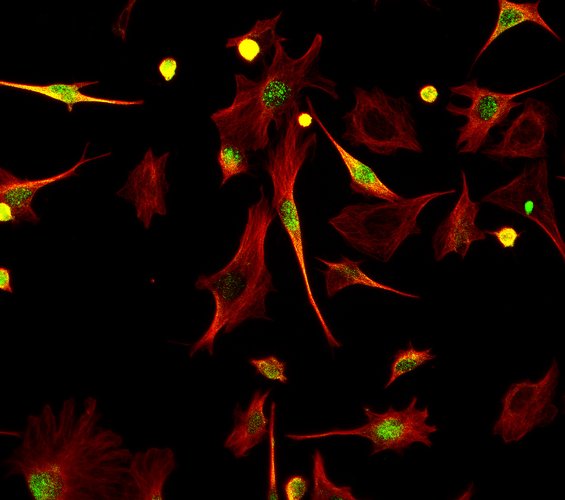How Cells Cope with Replication Stress
Share
DNA damage frequently occurs during cell division, its repair is essential for survival for every organism. Scientists at CeMM have now discovered new mechanisms that maintain genetic material during cell division. Their study was published in Cell Reports and provides new potential approaches for cancer and Alzheimer's therapy.
Reproducing is stressful, a fact well-known to all parents. Yet, it also applies to the smallest units of life: The cells. Each cell division requires a duplication of its entire genetic material, frequently resulting in damage to the enormous DNA molecules – the cell is experiencing "replication stress". In collaboration with the Max Planck Institute of Biochemistry in Martinsried, Germany, the University of Sheffield, UK, and the John Hopkins University School of Medicine in Baltimore, USA, Joanna Loizou, Principal Investigator at CeMM, and her team have now discovered previously unknown mechanisms that protect cells from damage.
Previous experiments have shown that ATM, a kinase that is actually known for other DNA repair processes, also plays a decisive role in DNA repair during replication. This discovery led the scientists to trace the precise reaction paths of ATM and its cofactor ATMIN within a large-scale study. With resounding success: "For the first time, the complete workings of this important kinase and its activation protein is now understood," says Joanna Loizou. For her study, the scientist and her team compared both the complete RNA set – and thus the gene activity – as well as all proteins from cells that were missing the gene for ATM or its activation protein ATMIN with RNA and proteins from normal cells.
"We were able to examine the functionality of ATM and ATMIN in a very unbiased manner based on these enormous datasets," emphasised Joanna. "We have gained insights in proteins involved in cancer and Alzheimer's disease." One result was of particular interest: ATMIN chemically changes a protein (CRMP2) in the same manner as observed in the nerve cells of Alzheimer's patients. “It is well-known that neurodegenerative diseases are frequently associated with an accumulation of DNA damage in the brain. Thus, an interesting connection between ATMIN and Alzheimer's disease has been established that can perhaps help us better understand disease progression," says PhD student Abdelghani Mazouzi, first author of the study.
Publication:
Abdelghani Mazouzi, Alexey Stukalov, André C. Müller, Doris Chen, Marc Wiedner, Jana Prochazkova, Shih-Chieh Chiang, Michael Schuster, Florian P. Breitwieser, Andreas Pichlmair, Sherif F. El-Khamisy, Christoph Bock, Robert Kralovics, Jacques Colinge, Keiryn L. Bennett, and Joanna I. Loizou. A Comprehensive Analysis of the Dynamic Response to Aphidicolin-Mediated Replication Stress Uncovers Targets for ATM and ATMIN. Cell Reports 15, 1–16. DOI: http://dx.doi.org/10.1016/j.celrep.2016.03.077
Funding:
This study was partly funded by the Austrian Science Fund FWF and a DOC fellowship from the Austrian Academy of Sciences.

